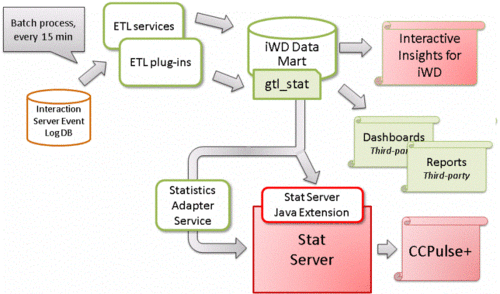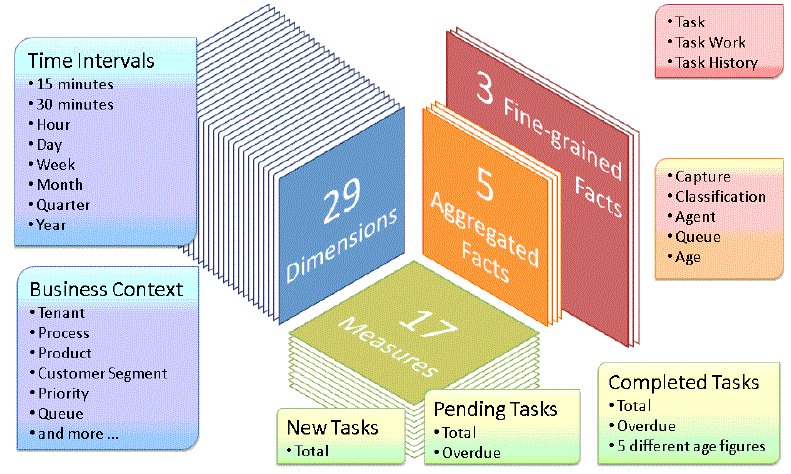IWD Reporting
The key to achieving the desired business results is having access to actionable business intelligence. Genesys iWD offers comprehensive reporting, providing management insight into business operation. It provides key indicators of performance both through current-day statistics and on an historical basis. The historical metrics are provided based on aggregates and measures that are populated by scheduled ETL processes, which extract data from the Genesys Interaction Server Event Log database and load it into the iWD Data Mart.
iWD monitors the entire lifecycle of tasks, from the moment that they are captured until they are stopped (removed from the system). iWD provides:
- Consolidated reporting across the various systems that are involved in customer-service delivery: fax servers, workflow, customer-relationship management, and Genesys Customer Interaction Management.
- Reporting that is based on business context—with business process, customer segment, and product independent of channel, instead of being limited to interactions, queues, channels, and workflows.
It does this by monitoring a number of events, including the following:
- New—The point at which the task was captured by the Capture Point
- Classification and Reprioritization Rules Applied—All rules that are applied to the task, as well as the values that are calculated and assigned to the task
- Queued—The point at which the task has been classified and prioritized and is awaiting potential reprioritization or assignment to a resource
- Assigned—When the task was assigned to an employee for processing
- Transfer/Transfer to Queue—Whether the employee transferred the task to another employee or back to the queue
- Held—Whether the task was held (manual hold)
Each record is timestamped and stored in the iWD Data Mart, where the data that is collected can be leveraged in third-party reporting applications.
Customers can build reports by querying the iWD Data Mart by using the reporting tool of their choice. In addition, Genesys offers the Interactive Insights for iWD product, which includes a data universe and nine out-of-the-box reports, built to be used with the iWD Data Mart. In addition to the iWD Data Mart, iWD 8.1 interoperates with Interaction Concentrator and Genesys Info Mart for historical reporting. Certain Info Mart fact tables (for example, MMEDIA_IXN_FACT_EXT and MMEDIA_SEG_FACT_EXT) store media-specific facts about open media as well as multimedia interactions and multimedia interaction segments.
iWD tasks all flow through Interaction Server queues as Open Media interactions (sometimes referred to as Third Party Media), so that these tables in Genesys Info Mart are populated with iWD data. Refer to the Interaction Concentrator and Genesys Info Mart documentation for more information.
Reporting Architecture
The following figure provides a functional overview of iWD’s reporting components. Third-party services can reference iWD statistics from the GTL_STAT table (GTL, for Global Task List) to display data in dashboards or within Genesys CCPulse+.
iWD Data Mart Database Objects
iWD Data Mart consists of the following database objects:
- Fine-grained fact tables—Store all attributes that are associated with tasks (I_TASK_FACT/H_TASK_FACT tables), work-related events (I_TASK_WORK_FACT/H_TASK_WORK_FACT tables), when the task was assigned to one or more agents; and a full audit history of the task (I_TASK_EVENT_FACT/H_TASK_EVENT_FACT tables).
- Aggregated fact tables—Describe tasks in an iWD-oriented context across the various stages, or the iWD life cycle of the task, from capture and classification to distribution to agent.
- Dimensions—Describe task attributes that are common across the fact tables in iWD Data Mart, such as iWD business process, priority, business value, and date and time. Fact tables link to these dimensions through keys.
- Measures—Represent numerical values (such as totals, durations, averages, minimums, and maximums) that are stored in aggregated fact tables across intraday and historical intervals. For example, the total number of completed tasks by 15-minute interval by an iWD process and business value would be captured within the I_TASK_CAPT_FACT_15MIN intraday table.
When they are connected to existing enterprise data marts, including Genesys Info Mart, analysts gain access to comprehensive views of the entire customer experience. Analytical reporting leverages existing business intelligence tools, such as those that are provided by Pentaho (which is an open-source product suite for business intelligence) or through a host of commercial products from Cognos or SAP Crystal Reports.
Refer to the Data Mart Reference Guide for more information.


